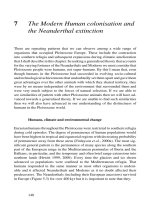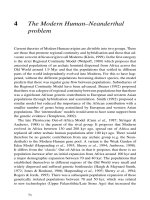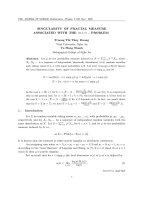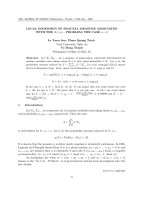The Modern Human–Neanderthal problem
Bạn đang xem bản rút gọn của tài liệu. Xem và tải ngay bản đầy đủ của tài liệu tại đây (117.48 KB, 23 trang )
4 The Modern Human–Neanderthal
problem
Current theories of Modern Human origins are divisible into two groups. There
are those that promote regional continuity and hybridisation and those that ad-
vocate a recent African origin to all Moderns (Klein, 1999). In the first category
is the strict Regional Continuity Model (Wolpoff, 1989) which proposes that
ancestral populations of an archaic hominid dispersed from Africa across the
Old World around 1.9 Myr and that the populations that settled in different
parts of the world independently evolved into Moderns. For this to have hap-
pened, without the different populations becoming distinct species, the model
predicts that there was regular gene flow between populations. Subsidiaries of
the Regional Continuity Model have been advanced. Brauer (1992) proposed
that there was a degree of regional continuity between populations but that there
was a significant African genetic contribution to European and western Asian
populations through hybridisation and assimilation. Smith (1992) proposed a
similar model but reduced the importance of the African contribution with a
smaller number of genes being assimilated by European and western Asian
populations. The ‘intermediate’ models would seem to have some support from
the genetic evidence (Templeton, 2002).
The late Pleistocene Out-of-Africa Model (Cann et al., 1987; Stringer &
Andrews, 1988) is the parent of the rival group. It proposes that Moderns
evolved in Africa between 130 and 200 kyr ago, spread out of Africa and
replaced all other archaic human populations after 100 kyr ago. There would
therefore be no genetic contribution from any archaic group (e.g. the Nean-
derthals) to the Modern Human gene pool. A variant is the Weak Garden of
Eden Model (Harpending et al., 1993; Sherry et al., 1994; Ambrose, 1998).
It differs from the ‘classic’ Out-of-Africa in that it proposes that there is no
population increase after an initial expansion from Africa around 100 kyr and
a major demographic expansion between 70 and 40 kyr. The populations that
established themselves in different regions of the Old World were small and
widely dispersed and suffered genetic bottlenecks (Haigh & Maynard Smith,
1972; Jones & Rouhani, 1986; Harpending et al., 1993; Sherry et al., 1994;
Rogers & Jorde, 1995). There was a subsequent population expansion of these
genetically isolated populations between 70 and 50 kyr, which was related
to new technologies (Upper Palaeolithic/Late Stone Age) that increased the
71
72 Neanderthals and Modern Humans
environmental carrying capacity for human populations. The Multiple Disper-
sals, Bottlenecks and Replacement Model attempts to provide a mechanism for
ex-African expansions. This model sees the environment as the driving force
(Lahr & Foley, 1994, 1998; Foley & Lahr, 1997) and the Middle to Upper
Palaeolithic technological transition as a key factor. According to this model
the ancestral African population was reduced in size, experiencing a genetic
bottleneck, due to climate-driven habitat fragmentation. A series of population
increases with dispersal followed by further bottlenecks characterised human
expansion. According to Lahr & Foley (1998) the ancestor of the Neanderthals,
that they name Homo helmei, would have dispersed within and out of Africa
during Oxygen Isotope Stage (OIS) 7 or 8. The first dispersal, into the Middle
East, occurred during the mild OIS 5. Subsequent cooling caused a population
retreat, these Modern Humans being presumed not to be behaviourally or phys-
iologically adapted (or at least not as well as the contemporary Neanderthals)
to the cold of Eurasia. A second dispersal, in OIS 4 or early OIS 3, enabled
the dispersal of a population into Asia and a final one, around 45 kyr, coincid-
ing with the Middle–Upper Palaeolithic transition, into the Middle East was
rapidly followed by the colonisation of Europe. This model recognises that, as
Moderns spread they replaced archaic populations including the Neanderthals.
Lahr & Foley (1998) attempt to provide a mechanism that is based on exist-
ing theoretical frameworks of evolutionary ecology and biogeography. They
also recognise that evolutionary events, such as Modern Human origins, have
a strong geographical component and highlight the vital link between demog-
raphy and spatial distribution.
The alternatives available to us until now have therefore required that the fate
of archaic groups is determined either by ‘eviction’ or ‘continuity/replacement’
(Lahr & Foley, 1998; Tattersall & Schwartz, 2000). An alternative hypothesis
has recently been proposed that does not require the intervention of Moderns
in the extinction of the archaics which is seen as part of a natural and recurring
process of habitat fragmentation during glacial cycles that severely affected
non-tropical hominid populations (Finlayson, 1999; Finlayson et al., 2000a).
This model, which is developed in this book, differs from the traditional and,
until now apparently mutually exclusive, alternatives of replacement (usually
by competition) or continuity that do not consider non-human related extinction
of archaic populations, including the Neanderthals, to be important. Patterns
of hominid evolution and the key elements of Modern Human behaviour can
be explained within the framework of the general principles of evolutionary
ecology (Foley, 1992). This alternative model is precisely based on theoretical
evolutionary ecology and geography (Hutchinson, 1959; MacArthur & Wilson,
1967; MacArthur, 1984; Brown, 1995).
Modern Human–Neanderthal problem 73
The use of culture as an all embracing and all pervading explanation to the
evolution of Moderns has obscured the processes by which Moderns evolved
(Foley, 1989). Throughout this book I view humans as components of ecological
communities with the driving force behind change being natural selection acting
to ‘keep up’ with the spatio-temporal heterogeneities of Pleistocene Earth. As
these heterogeneities became more marked so populations that were adapted
to cope with change fared best. Behavioural attributes that permitted rapid
adjustments to change were selected. Humans increasingly became refined risk
managers.
The species problem
Before discussing the biology of Neanderthals and Modern Humans we should
establish who they were and what their relationship to each other was. The de-
bate concerning Modern Human origins often seems to revolve around whether
or not followers of a particular camp regard the two to be distinct species or
not. The point about the definition of Neanderthals and Moderns, or indeed any
other human, is that it is a taxonomic concept. The discussion about human
origins must be an evolutionary one and, whether or not we are advocates of
cladistics, taxonomy should only be seen as a convenient tool in packaging and
not as a proxy for evolutionary thinking. In evolutionary terms it does not matter
what we call Neanderthals or Moderns. The point is that the genetic evidence,
which is the only reliable tool that we have today, indicates that Neanderthals
and Moderns had a common ancestry that can be approximately dated at around
500–400 kyr and that the two lineages apparently went along separate paths,
one in Eurasia and the other in Africa. Physical barriers, aided by climate, ap-
parently kept the two lineages apart until they re-met in Eurasia some time after
100 kyr ago (depending on location). We presume they did not have genetic
contact in the interim but it is only a presumption. As we saw in the previous
chapter it is a presumption that is unlikely to have held across the entire geo-
graphical range throughout the period 500–40 kyr. What happened when the
two lineages met? We cannot be certain because the evidence is so meagre.
One thing seems clear from the genetic evidence – no Neanderthal genes sur-
vived (Krings et al., 1997, 1999, 2000; Ovchinnikov et al., 2000). We should
not be surprised if at some point in the future contrasting evidence is found.
Why could Neanderthals and Moderns not interbreed and leave mixed traits?
There is no biological reason whatsoever but clearly, on present evidence, the
Neanderthal genetic contribution is nil and may have at best been very small.
There is no reason either to suspect a uniform pattern across space. Put in simple
74 Neanderthals and Modern Humans
terms – what happened in France need not have been the same as what happened
in Java.
The origins of humans (members of the genus Homo) date approximately to
the Plio-Pleistocene boundary around 2 Myr (Wood & Collard, 1999; Hawks
et al., 2000). Whether we choose to consider H. erectus and H. sapiens to be
a single, evolving, species (Hawks et al., 2000; Wolpoff & Caspari, 2000) or
separate species (Stringer, 2002a; Tattersall, 2002) does not alter the nature of
the discussion of this book that is concerned with the evolutionary ecology of
populations and not with taxonomic definitions. For the purpose of this book it
is enough to recognise a speciation event, probably subsequently unparalleled,
somewhere near the Plio-Pleistocene boundary that led to the first member of
the genus Homo (Mayr, 1950; Wolpoff & Caspari, 2000). Thereafter, we lack the
resolution to allow precision in the identification of lineages as the Pleistocene
picture is likely to have been so complicated spatially and temporally. In this
context we should note that, in North American songbirds at least, the paradigm
that many species originated as a consequence of the late Pleistocene glaciations
has been shown to be flawed. Instead the glaciations were an ecological obstacle
through which only some species were able to persist (Klicka & Zink, 1997).
There is no doubt that, among humans, there would have been many cases
of geographical separation leading to the emergence of distinct populations.
Where isolation was sufficiently long the trajectories, as in the case of the
Neanderthals, would have led to distinct morphological and related features.
This, on its own, does not make the Neanderthals a distinct species as some
authors seem to suggest (Lieberman et al., 2002). Whether such differences
were of a kind that precluded interbreeding when populations met once more,
thus confirming the presence of distinct biological species (Cain, 1971), is
something that we cannot answer today. In any case we have to be aware
that reproductive isolation even between good species may, in some cases, be
imperfect (Schluter & Nagel, 1995). Morphological distinctness, the basis for
allocating fossils into species, is only a general, and not infallible, guide in the
delimitation of species (Simpson, 1951; Cain, 1971). The weakness of relying
on morphology is especially evident if we consider the phenotypic plasticity of
most organisms (Geist, 1998). Genetic differences are, equally, subject to our
own protocols and definitions. The splitting of the Homo phylogeny is therefore
subjective and not directly relevant to the question of Modern Human origins
and the extinction of archaic populations.
So there would have been multiple branches in the evolution of Homo in
the Pleistocene, especially as the geographical range expanded and the chances
of isolation became greater. There must also have been continuity in at least
one population, that which led to the Moderns. We may therefore best regard
modern H. sapiens to be the terminator, for now, of an ancestral-descendant
Modern Human–Neanderthal problem 75
sequence of interbreeding populations that evolved independently of others –
the gens described by Simpson (1951). A number of authors have attempted to
link the emergence of Moderns to a speciation event (Crow, 2002). The evidence
in favour is inconclusive. A study of a highly variable sub-terminal non-coding
region from human chromosome 16p13.3 did not reveal a signal for population
growth in Africa that would be expected if such a speciation event had taken
place (Alonso & Armour, 2001).
Evidence of widespread hybridisation between Neanderthals and Moderns
would certainly be suggestive but so far we only have the claim from Lagar
Velho in Portugal (Duarte et al., 1999; Zilhao & Trinkaus, 2002), based on
morphology, and that is it. This recent discovery of a skeleton in Portugal,
claimed to be a Modern–Neanderthal hybrid and dated at 25 kyr (Duarte
et al., 1999), is in apparent conflict with the genetic evidence. The skeleton
was found buried in a distinctively Upper Palaeolithic pattern, implying be-
havioural modernity, but its anatomy was claimed to be a mosaic of Neanderthal
and early Modern Human features. The claim has been vigorously contested by
some who feel that the skeleton lacks distinctive Neanderthal features (Tattersall
& Schwartz, 1999). Duarte et al. (1999) and Zilhao & Trinkaus (2002) claim
the skeleton as evidence in support of interbreeding between early Moderns and
Neanderthals. The authors recognised the inappropriateness of applying a strict
biological species distinction, based on reproductive isolation, to Neanderthals
and early Moderns. They also rejected hypotheses of full replacement of late
archaic humans by early Moderns everywhere outside Africa and instead saw
the need for an approach that brought together regional complexities, temporal,
human biological and cultural processes as well as the historical trajectories
that took place. If this child was a hybrid, then the claim for widespread hy-
bridisation between Neanderthals and Moderns rests on the dating evidence
that suggests that the hybrid was in existence up to 5 kyr after the extinction
of the last Neanderthal in Portugal. We have to accept that transposing what
happened in a single valley to the whole world is risky. In the Middle East,
Neanderthals and Moderns supposedly occupied the same geographical area
for longer than anywhere else (Arensburg & Belfer-Cohen, 1998). It is an area
that has produced fossils of Neanderthals and Moderns but so far no hybrids. So
we cannot, presently, use the biological species concept to determine whether
we are dealing with one or two species. There is something that is even more
worrying and for that I must now turn to the question of convergent and parallel
evolution.
I have already said that the only available solid evidence that we can draw
upon is the genetic evidence. The reason is that I seriously question the valid-
ity of arguments based solely on morphological comparisons. The problem is
exacerbated by the small sample sizes available, which oblige researchers to
76 Neanderthals and Modern Humans
combine specimens from distant parts of the geographical range and from differ-
ent time periods, often making statistically unsatisfactory inferences. Through-
out the animal kingdom we find numerous cases of unrelated species converging
biologically in response to similar ecological problems (Cody, 1974, 1975). The
point is that the probability of convergence in response to similar pressures has
to, logically, be even greater among closely related forms because they are start-
ing off from templates that are quite similar to each other. This means that we
need genetic evidence to support any evolutionary conclusions that we draw
from morphology because genes tell us a history that is independent. So can
we differentiate, especially when we only have single or even small groups
of specimens, between lineages and convergence on morphology alone? The
answer is that we cannot.
At any point during the late Pleistocene, Neanderthals, Moderns and other
contemporary human populations are best regarded as a sapiens polytypic
species (Cain, 1971; Aguirre, 1994; Smith et al., 1995). A time slice at a point
in the late Pleistocene would reveal a range of human populations spread across
parts of Africa, Eurasia and Oceania. Some would have been genetically linked
to each other, behaving as sub-species, while the more extreme populations may
well have behaved as good species with minimal or no inter-breeding. The two
extremes were probably in operation at different times and in different parts of
the world. The human array at any point should best be regarded as a polytypic
species of common descent and varying degrees of subsequent isolation. This
view is in keeping with the increasing evidence that demonstrates that species
across their range are often divided into patchworks of parapatric sub-species
and races with intervening hybrid zones (Hewitt, 1989).
When a species is separated by a geographic barrier and the terminal forms
gradually diverge and eventually behave as two distinct species when they meet
on the other side we have an example of a polytypic species that is known as a
‘ring species’ (Cain, 1971). For Mayr (1942) such ‘circular overlaps’ perfectly
demonstrated the process of speciation. It is likely that the varying levels of
isolation, gene flow and distance among human populations in the Pleistocene
generated geographical distribution patterns at particular times that were akin to
the ring species concept. For this reason it will be useful to explore this concept,
and its most recent developments in particular – sympatric and parapatric speci-
ation – a little further. In particular, I focus on the effects of gene flow in prevent-
ing speciation. The Out-of-Africa vs Multiregional debate focuses on whether
there was isolation or gene flow between Pleistocene human populations
(Hublin, 1998; Hawks & Wolpoff, 2001). Genetic exchange undoubtedly slows
down the rate of divergence of two populations (Irwin et al., 2001; Porter &
Johnson, 2002) but a more pertinent question is by how much? Recent specia-
tion models have highlighted the importance of local adaptation as a process that
Modern Human–Neanderthal problem 77
can oppose gene flow leading to rapid population divergence to the level of full
species (Rice & Hostert, 1993; Johannesson, 2001). Even in cases of complete
sympatry, strong selection can eliminate gene flow between populations lead-
ing to very rapid speciation (Gavrilets et al., 1998; Kondrashov & Kondrashov,
1999). Even though sympatric speciation is likely to be rare it appears a distinct
possibility in competitor-free, resource-diverse, environments (Dieckmann &
Doebeli, 1999; Filchak et al., 2000; Wilson et al., 2000) and minor changes
in the selective environment can cause population divergence (Danley et al.,
2000). According to Gavrilets et al. (1998), rapid speciation is also possible
without the need for extreme founder effects, complete geographical isolation
or selection for local adaptation. Short-term reductions in migration rate were
sufficient to produce significant and irreversible divergence and reproductive
isolation in just several hundred generations. Divergent selection pressures be-
tween populations can also lead to divergent sexually selected traits, if these
are favoured in different environments (Endler, 1992; Schluter & Price, 1993;
Schluter & Nagel, 1995; Irwin, 2000; Irwin et al., 2001; Johannesson, 2001).
Development, by providing a context for cryptic divergence in the allelic basis
of regulatory interactions and creating interspecific incompatibilities, also in-
creases the probability of speciation even in cases of strong gene flow (Porter &
Johnson, 2002). At the other end of the scale we have the classic allopatric spe-
ciation models in which geographically isolated populations can diverge due to
genetic drift even in the absence of strong divergent selective pressures but this
process will be severely curtailed in the presence of migration.
Irwin et al. (2001), in their review, concluded that the role of gene flow in
preventing differentiation of the terminal forms of a ring species should be
highly dependent on whether initial substitutions were favoured everywhere or
only in parts of the species range. We can at least conclude that demonstration of
gene flow in the case of sympatric or parapatric Pleistocene human populations
does not automatically preclude lineage divergence, or indeed even speciation.
Given the differences in spatial ecology between Neanderthals and Moderns,
that will become apparent in this book, we should not be surprised to observe
lineage separation in the presence of varying degrees of gene flow as detected
by Templeton (2002).
Sympatry or allopatry?
The situation that arose in Europe and western Asia that concluded with the
extinction of the Neanderthals and the colonisation of the Moderns was not
exceptional, as we saw in the previous chapter. The pattern of extinction of
Neanderthals does not follow an east to west gradient as would be expected
78 Neanderthals and Modern Humans
if the Moderns arriving from the Middle East had replaced them. Instead,
Neanderthals became extinct across the mid-latitude belt from Portugal to
the Caucasus at about the same time (31–29 kyr) (Finlayson, 1999; Finlayson
et al., 2000a; Ovchinnikov et al., 2000; Zilhao, 1996; Smith et al., 1999; Chap-
ter 7). Populations that had occupied areas to the north, around the North
Eurasian Plain, became extinct earlier (by 40 kyr). This, together with the
long-established contemporaneity of Neanderthals and Modern Humans in the
Middle East for thousands of years (Bar-Yosef, 1998) questions the long-held
view that Moderns caused the Neanderthal extinction. The dating of a Javan
specimen, attributed to H. erectus, at 25 kyr (Swisher et al., 1996) indicates a
late persistence of archaic humans also in tropical South-east Asia. Since we
now know that Moderns had reached well into Australia by 50 kyr (Thorne et al.,
1999; Bowler et al., 2003), protracted geographical overlap between Moderns
and archaics must have been widespread. Questions that relate to reproductive,
ecological and behavioural interactions in areas of geographic overlap (sympa-
try) therefore assume a greater relevance. Because the European–Middle East-
ern region is the best documented, it is issues of Modern Human–Neanderthal
interactions that are receiving prominence. Sympatry would have been possible
if Neanderthals and Moderns had sufficiently different niches to permit ecologi-
cal isolation (Lack, 1971; Cody, 1974) or if numbers were such that populations
were below carrying capacity. Competition would only occur in situations in
which the populations were at carrying capacity and resources became limit-
ing. Differences in ecology may explain the long periods of sympatry (Mellars,
1996). Recent work suggests that Moderns and Neanderthals were ecologically
separated and had distinct habitat preferences (Finlayson, 1999; Finlayson &
Giles Pacheco, 2000). Improved resolution of climatic data is allowing greater
precision in linking ecological change with human behaviour (van Andel &
Tzedakis, 1998). The rapid changes during the late Pleistocene (Allen et al.,
1999) especially in zones of sharp ecological transition (Peteet, 2000) have clear
implications for the survival of populations, including hominids. The impor-
tance of temperate and tropical refugia is also being re-assessed and isolation in
cold-stage refugia (e.g. Iberia, southern Italy, Balkans) is reflected in distinctive
present-day patterns of genetic variation and subdivision among widely differ-
ent animals (Willis & Whittaker, 2000). The evidence increasingly points to the
Modern expansion and the Neanderthal extinction being the products of habitat
and resource change during the late Pleistocene, with southern refugia playing
a critical role in the outcome (Finlayson, 1999; Finlayson & Giles Pacheco,
2000). The degree of interaction between Moderns and Neanderthals would
have been minimised by ecological separation. Contact would be predicted to
be greatest where heterogeneous landscapes were close to the plains and would
therefore have been localised. So far the only case of apparent hybridisation, as
Modern Human–Neanderthal problem 79
we have seen, is the Lagar Velho child (Duarte et al., 1999; Zilhao & Trinkaus,
2002). The key is not whether hybridisation occurred but its effect on the hu-
man gene pool. Given the available genetic evidence (Krings et al., 1997, 1999,
2000; Ovchinnikov et al., 2000; Caramelli et al., 2003) it would seem that
such hybridisation must, at best, have been restricted to localised hybrid zones
(Hewitt, 1989). In the same way, the conditions required for competition
(Finlayson et al., 2000b) would not appear to hold given the low population
densities (Mussi & Roebroeks, 1996; Harpending et al., 1993) resulting from
the constantly and rapidly changing climate (GRIP, 1993; Allen et al., 1999).
Competition, like hybridisation, may have been a very local phenomenon with
no consequence to the Neanderthal extinction. It would be very informative to
have ecological data from South-east Asia where late H. erectus and H. sapiens
must have been sympatric for at least 25 kyr.
Genes
Studies of mitochondrial (mtDNA) and fossil (fDNA) Neanderthal DNA
(Krings et al., 1997, 1999, 2000; Ovchinnikov et al., 2000; Scholz et al., 2000)
indicate their genetic distinctness when compared to present-day humans. We
lack, however, a comparison with Modern Humans that were contemporary with
the Neanderthals (Wolpoff, 1998) although a recent comparison with 24 kyr-old
Modern Humans indicates a genetic discontinuity (Caramelli et al., 2003). In
any case these observations do not exclude the Multiregional model (Nordborg,
1998; Reletheford, 1999). The time of the last common ancestor of Modern
Humans and Neanderthals is now put within the time frame of 317–741 kyr,
possibly around 465 kyr (Krings et al., 1997, 1999; Ovchinnikov et al., 2000).
From the limited data available the provisional conclusion that may be drawn
about Neanderthal genetic diversity is that it was low, comparable to Mod-
erns, and much lower than for the great apes. Since Neanderthals had a larger
geographical range than the apes, it appears that the Neanderthals may have
expanded from a small population (Krings et al., 2000). If so, it would seem
that Neanderthals were similar to Moderns in demographic expansion charac-
teristics, low mtDNA and nuclear diversity in Moderns being equated to a rapid
population expansion from a small population (Jorde et al., 1998).
Many genetic studies in the 1980s and 1990s seemingly clarified the ques-
tion of a single African origin (between 100 and 200 kyr) and the timing of
genetic differentiation of human populations around 100 kyr (Cann et al., 1987;
Vigilant et al., 1991). However, not all molecular clocks tick at the same rate
(Strauss, 1999) and there may even be variations in rate through time within
the same lineage. A number of studies now propose faster mutation rates than









